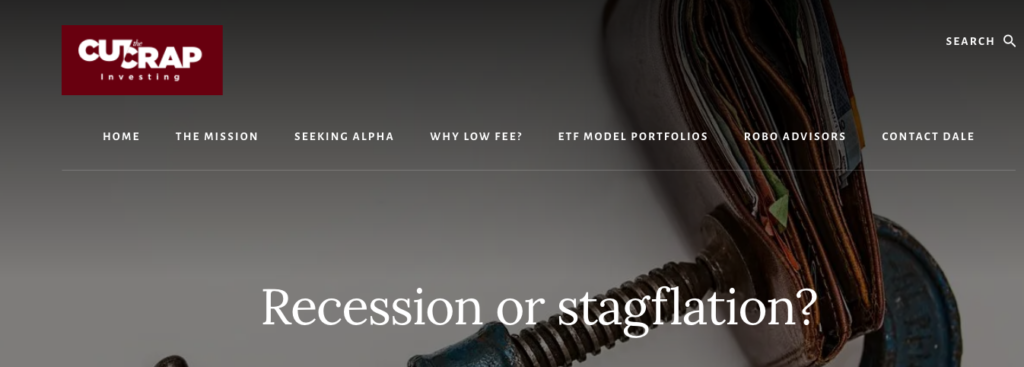By Dale Roberts, cutthecrapinvesting
Special to the Financial Independence Hub
Many economists and market experts are suggesting that the outcome for 2022 and into 2023 might be that we experience a recession or stagflation. That’s not a good choice we might think. And of the two ‘options’, we might prefer a recession. A recession might do enough to quell inflation. And we do have to stomp out inflation hard the first time. That is, central bankers have to raise rates aggressively enough to hurt the consumer enough to reduce demand and get inflation well under control. If they let inflation fester, it may resurface and cause even more trouble as it did in the 1970’s stagflation era. Recession or stagflation, who knows what we will get. The idea is to be aware and prepared.
Recession or stagflation?
In the Globe & Mail (paywall) Ian McGugen asked the question: What comes next: stagflation or recession?
Given that it may be the very unfortunate war in Ukraine that pushes us over the edge I suggested that a Russcession is coming. From Ian …
As anyone who has read a bear-market headline has gathered by now, the economic outlook is turning ugly. The question that lingers is just what form of ugliness it will take.
In one scenario, soaring interest rates and climbing oil prices clobber the economy, leading to a painful but short recession that stamps out today’s roaring inflation.
In another scenario, a recession may be averted, but inflation isn’t. The economy stumbles along in a stagflationary funk as rising prices continue to ransack consumers’ wallets.
Of course, we don’t know what we’re going to get. We can also add a soft (economic) landing in the mix. The central bankers raise rates and make enough noise to spook the consumer enough to bring down inflation while not creating a recession. Or perhaps we get a soft and quick recesssion? Who knows? Nobody knows.
That’s why we prepare for the the unknown, for a future that we do not know.
A must read: the new balanced portfolio.
The history of bears and corrections
Here is a post that looks at the history of stock market corrections and bear markets (a correction of 20% or more). As of this writing (originally in mid June) U.S. stocks recently tipped into bear market territory. Canadian stocks are now in correction mode (down 10% or more).
It is important to be aware of the potential for portfolio decline, and also to know how long you might have to grin and bear it as you buy stocks on the way down.
And yes, if you’re in the accumulation stage, you’re a buyer. Building wealth can be and should be super easy, but it can be emotionally taxing. Maybe a better way to frame it is that building wealth is super easy, keeping that wealth is not so easy.
Stock market corrections and bear markets are wealth building turning points. We need to hang on to our past gains (don’t sell). Corrections and lower stock prices are wonderful long-term wealth building opportunities. Some of the best buying opportunites are offered during corrections and bear markets.
Not cheap, yet?
And sure, U.S. stocks are not that cheap. From Scott Barlow, citing a Goldman Sach’s report: Despite the 18% YTD S&P 500 decline, equity valuations remain far from depressed. The median S&P 500 constituent’s P/E ratio of 18x ranks in the 87th percentile since 1976. For context, in March 2020 the median stock’s P/E was 14x .
Translation: at current valuations, U.S. stocks were still more expensive only 13% of the time, from 1976. That said, it is near impossible to time the markets. The dollar cost averager will find very good value along the way. The dollar cost averager will be buying at the market bottoms and will be lowering their average cost per share.
And recently I offered that Canadian stocks are looking good with respect to valuations.
And how about international markets?
Keep buying.
The upside of rising rates
Our savings account rates and bond yieds will increase. They are increasing. At EQ Bank many GICs are now above 3% and even 4%.
Stocks are looking better but there may be more pain to come.
Bonds are looking better but there may be more pain to come. From Ian …
Bonds also hold out the possibility of capital gains down the road, because bond prices and interest rates move in opposite directions. This implies bonds should gain in value whenever central banks finally feel confident inflation is under control. At that point, policy-makers will presumably start to cut interest rates to support their ailing economies. Bondholders will prosper.
Hey, we buy stocks on the way down. If you invest in a balanced portfolio, the correct course of action includes buying bonds on the way down as well.
Dividends rule
Not to belittle the dividend approach, but the dividends (and counting the dividends) can be a useful distraction. And more than that, in retirement, if your income stream grows or remains relatively stable, that can help you maintain your lifestyle. Seeing the rock of stable dividends can help you stay the course.
While these Canadian investors understand the importance of portfolio growth and total returns, they also like to watch and report on the impressive dividend growth.
Follow these blogs.
And here’s a larger list courtesy of Bob on Tawcan.
If counting dividends will help you stay the course, power to ya. And of course, there is no guarantee that dividends will always grow or remain stable. But I like your chances if you have a nice mix with a focus on defensive sectors. For an inflation-fighter I have added energy dividends. Our gas bill is covered by the energy holdings. #freegas
I like to build around a dividend stream. That said we should always consider greater portfolio diversification and the benefits of portfolio growth (total return).
Bonds and dividends?
Assume things are ugly. If we dont’ get ugly, then good.
Red-hot inflation like this leaves central banks with few options but to raise rates high enough to put the entire economy into a deep freeze. Nearly 70 per cent of leading academic economists expect the United States to fall into a recession next year, according to a survey conducted a week ago by the Financial Times and the University of Chicago.
Ian closed with …
Until this becomes clearer, maintaining a portfolio that holds both bonds and dividend payers looks like the best course of action in an increasingly ugly economy.
In the comment section of that Globe piece I offered that stock markets did not deliver positive, real (inflation-adjusted) returns during stagflation.
The idea that stock markets work is a big misconception. Unfortunately advisors and planners are taught that as well. That has ramifications for those in retirement.
Inflation fighters
Commodities work of course as they always do for excessive inflation. REITs worked. TIPS can work. Energy stocks work. And yes value and quality can work, that you might find in those big dividend payers, but know what you’re buying.
If you’re in the accumulation stage, you can ignore everything and keep buying. Dollar cost averaging is a wonderful weapon that does not need to guess.
I’m not worried. We’re on vacation. My dividends helped to fund the trip. I hold a nice mix of Canadian and U.S. dividend payers. There’s defense. I have a growth component. There’s a modest amount of bonds and cash. I use dedicated inflation fighters.
All good.
 Dale Roberts is the Chief Disruptor at cutthecrapinvesting.com. A former ad guy and investment advisor, Dale now helps Canadians say goodbye to paying some of the highest investment fees in the world. This blog originally appeared on Dale’s site on June 15, 2022 and is republished on the Hub with his permission.
Dale Roberts is the Chief Disruptor at cutthecrapinvesting.com. A former ad guy and investment advisor, Dale now helps Canadians say goodbye to paying some of the highest investment fees in the world. This blog originally appeared on Dale’s site on June 15, 2022 and is republished on the Hub with his permission.


